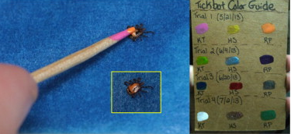|
written by: Michael Adu-Brew & Ben Burgunder When most people think of mathematicians, scenes of squawking flocks of birds being herded into arenas, tiny ticks being carefully painted with nail polish, and an army of permethrin-soaked undergraduate researchers do not come to mind. These people do not know Dr. Holly Gaff. On Friday, October 27th, Dr. Gaff, Professor and Chair of Biological Sciences at Old Dominion University (ODU), spoke to the UMD Department of Entomology about her exciting research on the ticks of southeastern Virginia. A mathematician by training, Dr. Gaff was ‘bitten’ by the tick research bug when she realized how mathematical modeling and simulation could help decipher the complex and unpredictable life histories of ticks that threaten public health across the country. To Dr. Gaff, ticks present an interesting modeling system because of their distinct life stages, rapid expansion into new territories, and heightened public awareness. However, lack of long-term and comprehensive tick datasets was hampering extensive modeling research. So, with the help of the ODU Tick Team, a collaborative project involving three other ODU professors and their respective labs, Dr. Gaff established tick sampling sites across southeastern Virginia. Over the past fifteen years, the team and a veritable army of undergraduate researchers have surveyed these sites, collecting ticks through a considerable range of collection techniques, including tick flagging (dragging a flag on a lightweight pole to pick up questing ticks) and through the trapping of small mammals, reptiles, and birds that often harbor ticks. This ever-expanding dataset allows Dr. Gaff and other members of the ODU Tick Team to undertake previously insurmountable research projects. One such project is investigating the distribution of a poorly studied and unpredictably dispersed species like the Gulf Coast tick (Amblyomma maculatum). Immature Gulf Coast ticks are most reliably collected on bird and rodent hosts. Since juvenile ticks of this species feed on highly mobile birds, they can rapidly spread with their winged hosts. The potential of these traveling ticks to establish new populations is a matter of public health concern due to their role in transmitting Rickettsia parkeri, an emerging human pathogen closely related to the species of bacteria that can cause Rocky Mountain spotted fever (RMSF). While the aches, rashes, and headaches that can result from R. parkeri rickettsiosis are not considered as severe as RMSF, controlling the ticks that transmit this disease still interests researchers and public health professionals. Without more information on the types of habitats that support new populations of this tick species, researchers cannot accurately predict their spread. Dr. Gaff utilized agent-based modeling, which focuses on specific tick-host interactions and tick life history data to better predict tick mortality, habitat type, tick behavior, and tick movement. This modeling approach allowed for an in-depth analysis of whether habitat quality or host density most affected tick population success at a given site. In the model, virtual habitats were assigned different levels of available hosts. A high host density could provide more resources and potential for movement for newly established ticks, while a low host density could stop a new tick population’s establishment in its tracks. Habitat quality was differentiated by how quickly ticks that are not on hosts would dry out and die. In poor habitats, ticks would dry out and die at a faster pace than in good quality habitats. When both levels of habitat quality and host availability were compared using agent-based modeling (Fig. 1), Dr. Gaff found that habitat quality was more important than host density in determining the successful establishment of new tick populations. These results suggest that those looking to manage or study the Gulf Coast ticks should focus on suitable habitats rather than the presence of preferred hosts when tracking their movement. Bot vs. Bird: Comparing management strategy effectiveness in controlling the lone star tick Unlike the Gulf Coast tick, the lone star tick (Amblyomma americanum) is not only easy to find in the field, but will actively seek you out! Named for the single white spot on the adult female’s back, this southeastern US species has rapidly expanded its range outward over the past few decades and has emerged as the overwhelmingly dominant species collected at Dr. Gaff’s study sites. While the lone star tick does not transmit Lyme disease, it can cause a red meat allergy to people it feeds on. This species’ saliva can contain alpha-gal, a sugar found in red meat. When a person’s immune system recognizes the tick saliva as foreign, they may register all future contact with this sugar as an attack, prompting an allergic reaction when that person consumes red meat. Lone star ticks can also actively pursue potential hosts like humans for up to 30 meters! This presents an enormous challenge to public health authorities since the ticks eliminated in a specific area can be rapidly replaced.  Fig. 3. Hand-painting individual ticks for mark and recapture. Source: Gaff et al. 2015 Fig. 3. Hand-painting individual ticks for mark and recapture. Source: Gaff et al. 2015 These concerns have inspired researchers like Dr. Gaff to innovate and implement wholly novel tick control strategies. What if a robotic vacuum could be used to lay waste to the ticks crawling around your house? Could it be used to temporarily knock down tick populations in high-traffic areas? Thus, TickBot, a tick-killing robot vehicle, was born. Armed with four wheels and a trailing banner of permethrin-treated cloth that kills ticks on contact, TickBot can be controlled by a human user to ‘sanitize’ linear swaths of high human-traffic areas like fields or hiking paths. To gauge Tickbot’s effectiveness in battle against lone star ticks, Dr. Gaff pitted the bot against a bird species. Guinea fowl, a domesticated relative of the chicken, is commonly described as an avian tick-eating machine, but tick researchers like Dr. Gaff suspect that their capacity for tick consumption may be overstated. Guinea fowl complicate integrated tick management because they themselves are hosts for lone star ticks (which was documented for the first time in this study!), so their presence can simultaneously limit and increase tick populations. Using mark and recapture techniques, which involved hand-painting minute drawings onto lone star ticks, and agent-based modeling, the researchers found that the presence of fowl did not change the number of ticks in each area. TickBot ultimately emerged victorious over the fowl, as the modeled percent reduction of ticks solely using the bot was significantly higher than the reduction seen with 20 birds, the highest flock size considered. Innovative strategies like TickBot represent the future of managing tick populations that are too difficult for other methods. Author Bios:
Michael Adu-Brew is a master’s student working in the Krishnan Lab. His research focuses on assessing the risk of pesticides on non-target insects, particularly monarch butterflies. Ben Burgunder is a master’s student in the Fritz Lab. He is interested in whether mosquito vector community composition and West Nile virus prevalence can help explain patterns of human West Nile virus cases in Chicago. References and Links
Video: The ‘TickBot’ Takes the Bite out of Bugs Comments are closed.
|
Categories
All
Archives
June 2024
|
Department of Entomology
University of Maryland
4112 Plant Sciences Building
College Park, MD 20742-4454
USA
Telephone: 301.405.3911
Fax: 301.314.9290
University of Maryland
4112 Plant Sciences Building
College Park, MD 20742-4454
USA
Telephone: 301.405.3911
Fax: 301.314.9290


 RSS Feed
RSS Feed




